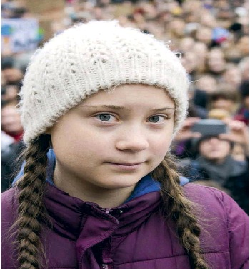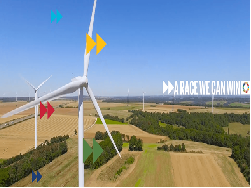Focus 2019 Culture and Society
Read the articles selected for the Sustainable Development Festival 2019
SDGs 13, 3
Greta Thunberg
By Sarah Diffalah
Source: L’Obs, 14 March

This girl, who has become the symbol of the future also thanks to her syndrome, so emblematic for the new generations, shows with her personal life how climate change is not something which concerns the others, but is deeply intertwined with our own existence.
SDGs 13, 10
Youth and the 2030 Agenda for sustainable development
Source: https://www.un.org
The 2030 Agenda challenges reveil their real, serious side if we think on youth. On the shoulder of the most vulnerable part of the world’s population will be built the sustainable development. Their rights and aspirations do matter more than their workforce and have a place in the 2030 Agenda.
Read more:
SDGs 13,9
Co-creative innovation must be core mission of universities
By Liz Newmark
Source: University World News, 12 March
Universities are becoming more able to address challenges like climate change, globalization and digitalization. Multidisciplinarity is the key to manage the amount of data provided by the economy of information.
Read more:
https://www.universityworldnews.com/post.php?story=20190312074208733
SDG 13
Building upon foundations for evidence-based policy
By Robert Hahn
Source: Science, 10 May
In the US, thinks tanks and academic circles are pushing the legislative machine towards a political method more based on the evidence of facts and on rigorous evaluations, to shift to that cultural change needed to address today’s political changes.
Read more:
https://science.sciencemag.org/content/364/6440/534
SDGs 13, 1, 10
Put equity first in climate adaptation
By Marc Pelling & Matthias Garshagen
Source: Nature, 14 May

To fight the poverty, policymakers should look at the bottom numbers of the poverty rates, and put the poor that don’t sum up the average in the centre of the governments’ agendas. In particular, the poorest are also the most vulnerable to climate change.
Read more:
https://www.nature.com/articles/d41586-019-01497-9
SDG 13
UN Climate Action Summit 2019
Source: https://www.un.org

The next UN Climate Summit, taking place on 23 September, wants to collect the energy of the movements of countries, companies, cities and civil society towards the objectives of the Paris Agreement, showing that keeping the global temperature below 2°C above preindustrial levels is still possible.
Read more:
https://www.un.org/en/climatechange/un-climate-summit-2019.shtml
SDG 13
Global warming has increasedglobal economic inequality
By Noah S. Diffenbauch & Marshall Burke
Source: asvis.it

This article tries to demonstrate that the anthropogenic climate change has sharpened inequalities between warm and cool countries due to the different effect of the heightened temperatures on the economic growth, in addition to the inequal distribution of the benefits of the fossil fuel use.
Read more:
https://www.pnas.org/content/early/2019/04/16/1816020116
SDG 13
Climate Change Adaptation in Africa
Source: http://www.undp.org
Climate change is the most disruptive risk factor for the efforts displayed in these decades to reduce hunger and disparities and that have in fact achieved an impressive growth in Africa in the last decades. Climate change adaptation is the result of transformational thinking and bold actions in all the topics of the 2030 Agenda.
Read more:
SDGs 13, 10, 8
Global environmental consequences of twenty-first-century ice-sheet melt
By Nicholas Golledge etc.
Source: Nature, 6 February
As mass loss from the Antarctic and Greenland ice is accelerating , the global sea level rising and the Atlantic overturning circulation slowing, the ice-ocean- atmosphere feedbacks that may arise as a consequence of ice-sheet melting, though spatially variable, will affect the Earth system with societal and economic consequences.
Read more:
https://www.nature.com/articles/s41586-019-0889-9
SDG 13
New climate models predict a warming surge
By Paul Voosen
Source: Science, 16 April
After the new models used to simulate global climate patterns , the world could warm 2°C within the next few decades, revealing a dangerous trend toward a 5°C rise in temperatures over preindustrial levels, which has less time to be contrasted than thought.
Read more:
https://www.sciencemag.org/news/2019/04/new-climate-models-predict-warming-surge
SDGs 16, 8
Investing in people. Creative Europe 2021-2027
Fonte: European Commission
Creative Europe is a new European programme for the culture and creativity, produced and expressed in different sectors of the cultural industry, to promote common values and economic growth, while addressing the central challenges of our time.
Read more:
SDGs 16, 13
The Global Risks Report 2019
Source: http://www3.weforum.org
A new era of state-centered politics , projected in the own domestical interests, sees geopolitical and geoeconomic tensions hardening. In this context, global challenges like environment protection and the human side of global risks shift in the second line.
Read more:
http://www3.weforum.org/docs/WEF_Global_Risks_Report_2019.pdf
SDGs 13, 16
Going for green(er) growth – what can indicators tell us?
Source: http://www.oecd.org
Green growth is as much an elusive as an inexhaustible concept, which indicates the ties between every economic activity and one broadly-defined environment. A set of key indicators identify the structural reform priorities for long-term economic growth and well-being.
Read more:
SDGs 13, 16
Groundswell. Preparing for internal climate migration
Source: https://www.worldbank.org/
This report shows the human face of the migration issue, delivering a set of indicators that help countries understand the interactions among climate impacts, ecosystems, livelihoods and mobility and integrate climate migration into national development plans.
Read more:
file:///C:/Users/Roberta%20Capo/Downloads/WBG_ClimateChange_Final.pdf
SDGs 16, 13
L’Italia chiama Europa. L’ambiente ritrovato
Source: WWF
In the same way it has built from the ruins of the World War the Single Market, Europe has elaborated from the failure of the past economic models a new, valorial concept of well-being through all the Union’s policies, in which is realized and evolving the concept of sustainable development expressed by the UN.
Read more:
SDGs 16, 11
Environmental rule of law
Source: https://wedocs.unep.org
The thought about Sustainibility in the intersection of environmental, socio-economic and public health claims has led to the development of a national and international environmental legislation more and more prolific, though often lacking the rule of law, crucial for the necessarity and effectivity of legislative declarations.
Read more:
SDGs 16, 11
Ready to help?
Source: oecd.org
This report is a tool for preparing the host countries to manage the migrants flows, showing that the lack of a plan to cope with the emergency and the integration sharps the perception of the problem, triggering a political crisis which the humanitarian situation in itself would not justify.
Read more:
https://read.oecd-ilibrary.org/social-issues-migration-health/ready-to-help_9789264311312-en#page13
SDGs 16, 11
Europe’s approach to implementing the Sustainable Development Goals
Source : the European Parliament
The EU shows an ambitious approach to sustainable development. But it is equally clear the need to implement the coordination between the different levels of administration, so that, in the light of the Agenda 2030, the economic aspect doesn’t dominate the environmental and social dimensions.
Read more:
http://www.europarl.europa.eu/RegData/etudes/STUD/2019/603473/EXPO_STU(2019)603473_EN.pdf
SDGs 16, 10
Growth can overcome the loss of faith in global co-operation
By Christine Lagarde
Source: The Economist, 19 September

The SDGs are the antidote to the lost of trust in the institutions, and the rise of social unjustice in the most advanced economies. They represent the hope in the future, when incomes inequalities and inequalities of opportunities are undermining the sense of community and the idea of a meritocratic society .
Read more:
SDGs 16, 3, 8
Safety and health at the hearth of the future of work
Source: ILO
The recognition of safety and health at work is the fundament of any other right. OSH have an impact on the life of people in general and on the whole society. Promoting a culture of forecasting and the education on OSH helps to develop a human-centred way to stay at work.
SDGs 10, 8
Online work in Oecd countries
Source: http://www.oecd.org
The platform economy can be seen as a new opportunity in the world of work, characterized by a greater flexibility, which raises concerns for labour and social protections. It’s an expanding phenomenon, yet not easy to understand, being mostly unreported and informal.
Read more:
http://www.oecd.org/els/emp/future-of-work/Online_Gig_Work.pdf
SDGs 5, 10, 9
OECD Skills Outlook 2019
Source: oecd.org
The lack of adequate competencies to actively enjoy the digital world of the work and the daily life, as well as the risk to strengthen inequalities, require a range of cognitive, socioemotional and digital skills to be developed, and to extend with appropriate policies the width of lifelong learning.
Read more:
https://read.oecd-ilibrary.org/education/oecd-skills-outlook-2019_df80bc12-en#page1
SDG 8
The future of work Oecd Employment Outlook 2019
Source: oecd.org
The transformations in the world of work require stronger social protections before the heightened uncertainties and the new forms of work emerging in a grey zone between dependent and self-employment, not at all defined by the current regulations , designed for the world of yesterday.
Read more:
https://www.oecd-ilibrary.org/sites/9ee00155-en/index.html?itemId=/content/publication/9ee00155-en
SDGs 16, 5, 10
General discussion on trafficking of women and girls in the context of global migration
Source: un.org
This paper frames women’s traffic in the context of the violation of human rights and of violence as the result of the combinated expressions of the Declaration on the Elimination of Violence against Women(DEVAW) and the Convention on the Elimination of Discrimination against Women (CEDAW).
SDGs 5, 10
Gender-inclusive language
Source: http://www.un.org

These Guidelines have been widespread by the United Nations among their staff to get them communicate in a gender-inclusive manner which means harnessing the properties of language to make women visible and raise awareness of gender discrimination.
Read more:
http://www.un.org/en/gender-inclusive-language/guidelines.shtml
Info
- Pubblicato il : 29/05/2019 Modificato il : 29/05/2019

